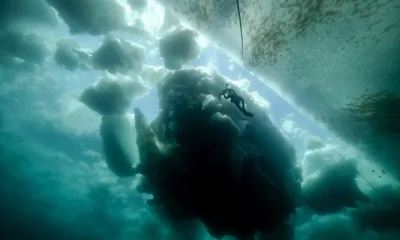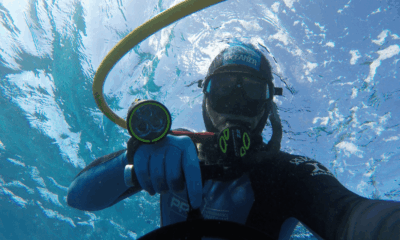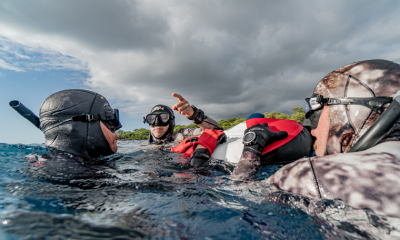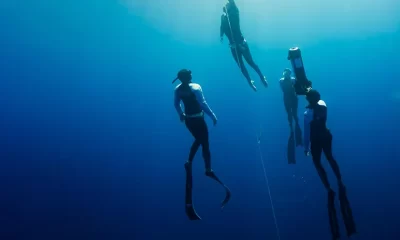Community
Freezediving: What Doesn’t Freeze You Makes You Stronger
What do you get when you cross a diver’s inner Wim Hof with the urge to exercise their mammalian dive reflex? Freediving cold enough to take your breath away, or at least form ice crystals on your mask. Meet Sabrina Figliomeni and the hardy souls who dub themselves “The FreezeDivers.” Their motto: “It’s not that cold!” (Yeah right!?!) What does it take to plan and execute a free, err freezedive under ice? Remove your thermals, take a deep breath and dive in!
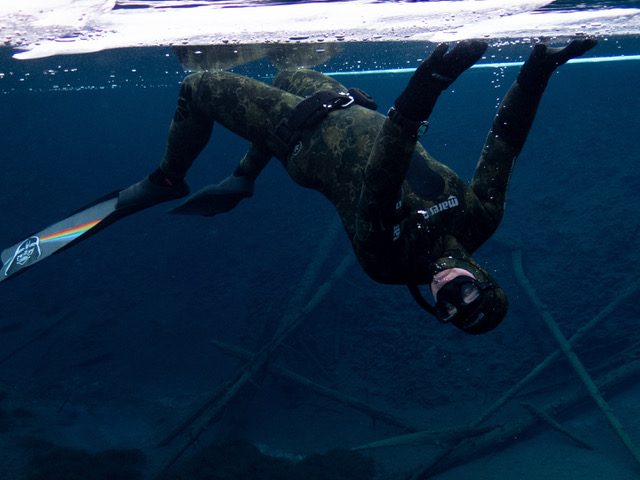
By Sabrina Figliomeni . Header image by Sabrina Figliomeni
?? Predive Clicklist: Do You Wanna Build A Snowman? from Frozen
“If the world is going to end in ice, we may as well cut a hole and go diving,” say a handful of people on the planet. It’s true that jumping into an ice hole—let alone freediving under ice—is not on many people’s bucket list. Setting aside the thought of a massive sheet of solid water over your head for a moment, there are other pre-dive factors to consider: first is the surface cold—so cold your mask is clearly frozen to your hood and your nose and lips are numb. You’re in a 7mm open cell neoprene wetsuit, sure, but the act of getting changed can be daunting, especially when your lube freezes to your skin, the wind springs up, and now you’re regretting not setting up the tent. Let’s face it: most divers consider water at 7° C/45° F to be the type of cold that is too uncomfortable regardless of wetsuit thickness. Knock it down a few degrees and for them it’s a solid “Hell No.”

A few of us semi-jokingly call ourselves “The Freezedivers.” We dive in the conditions described above regularly, partly because if we want to dive year-round we don’t have a choice, but also because we just really like it. Our group consists of a mix of divers of varying abilities. As of this writing, only one of us is a scuba diver (yours truly). There’s nothing inherently special about us—we’re not superhumans, we don’t have any genetic upgrades making us tougher than the average bear, we all feel the cold—and each of us is quite different from the other. However, interestingly enough, and in sharp contrast to our local scuba community, ten out of thirteen of the freedivers on our last outing were women.



For me, there’s something thrilling about being in water that cold, fending off errant chunks of ice and gathering stares from more logical humans bundled up in their winter garb. The meditative warmth I feel when I submerge myself in water cold enough to land me in the hospital cannot be understated. I experience sensations I never thought possible, even as my extremities go numb and I’m plagued by the Screaming Barfies* as the circulation comes rushing back.
Getting There
Forever in search of water to dive, our kind have been known to hike gear (including an ice fishing tent and small propane heater) to remote alpine lakes in the Canadian Rockies for a day of diving. The hunger to explore in these conditions doesn’t die down as the temperature plummets; we just adjust our exposure protection to match. Sometimes our efforts end up as futile cardio and we go get cheeseburgers. Sometimes we’re rewarded with optimal ice conditions, making it completely worth the trudge. A special treat is when we hike to a lake and find it only half-frozen. Having a partial ice sheet to play with is a unique level of fun that really brings out our inner goofballs. Ever tried pulling yourself across the underside of the ice with ice climbing tools? Ice diving is clearly an extremely serious business.
Part of getting ready for our ice dives is taking the time to set up our area properly, including setting up a tent when we can. The value of this one piece of gear cannot be understated; it’s a lifesaver and completely worth the carry weight when the wind picks up and we’re trying to take off our wetsuits. For some larger dive outings, we’ll set up hot water buckets for warming up toes, and continuous boiling water for lube and sometimes, warm soups. Just because we’re hardy enough to dive under ice doesn’t mean some of us aren’t (self-styled) divas.
Part of the preparation is also getting into the right headspace for this kind of diving. This is where you start to anticipate your dives and leave everything else in the background where it belongs. There is no room for the frustrations of everyday life in any overhead environment, especially one you’re exploring on one breath.
*Screaming Barfies are a delightful phenomenon we experience when ice climbing—when you’ve had your hands above your head holding on to tools for a period of time and the blood flow has deserted them, they’ve gone numb from cold, and you really can’t feel them. When you lower your hands and the blood comes rushing back, you experience a rather interesting pain as they warm up that makes you want to scream and barf at the same time. Thus, Screaming Barfies.



On our last outing, we cut two holes roughly 6 m/20 ft apart and hauled out the massive ice blocks. We had a dramatic cold snap a few months earlier (around -30° C/-22° F and below) which gave us some of the clearest ice we’ve had in years; it was so clear we could see each other as we swam between the holes. We rigged up each hole with a marked free-immersion line (we marked every meter, added weights at the bottom, and deployed a pulley at the surface in the event of a rescue scenario), and a secondary line for photographers as needed. We ran an additional safety line between the two holes. I popped my head in the water with a mask to check the visibility (which was a stunning 15 m/50 ft), no hood required. Even when the water is one degree, it’s really not that cold.
Taking the (Cold) Plunge
Into the water we went—breaking ice as it formed, cycling in and out, swimming between the holes to sneak up on each other and giggling as though we were at a water park. The biggest challenges with diving under ice are site setup and takedown, deciding whether you should pee in your wetsuit, and managing your mind. Site setup and takedown simply requires a lot of hands, a bit of cardio, and some creative gear packing. Peeing in your wetsuit is your call. Have fun with that one; I’d rather undo my wetsuit in the water than wreck my suit. However, managing your mind—this is the more interesting part.
There has been an increasing interest in cold immersion in the past year or two, brought on partly by the pandemic, but also by a renewed interest in the positive impacts proper breathing and the cold can have on your health. Cold immersion is a fantastic way to challenge yourself, build mental fortitude, and open up a winter of water if you’re willing to enjoy a bit of discomfort. Overall, people have developed an aversion to most things that are uncomfortable. Consider what you do in a day physically—you jump in the shower and crank up the hot water. You keep your house at a temperature warm enough for shorts. As for social discomforts, saying hello to a stranger walking by is awkward for most. This aversion to uncomfortable situations—both physical and social—can become a way of life.



Cold therapy, for one, has become easily accessible and can certainly introduce slightly less comfortable situations to a person’s normal routine. Breathwork in cold immersion also makes a huge impact. When you jump into a freezing lake, you might gasp at the temperature difference, and in some cases you can’t catch your breath. Part of the development of safe practices in cold water involves controlling your breathing and controlling your mind. There are multiple schools of thought on the best way to do this, but my approach has always been slow, intentional, and controlled breathing coupled with an enjoyment of everything you’re feeling (or not feeling). The more relaxed you are, the less your body thinks you’ve fallen off a ship into an icy ocean and are about to die.
When diving under ice, we are combining the cold water with an overhead environment just to make things a little spicier. We prepare with an appropriate breathe-up to calm the body and bring the mind into that same place. Some divers have mantras, some just enjoy the sensation and silence of preparation. You take that last preparatory breath and dive down. Depth isn’t important here—it’s all the experience. Ice is almost a living thing, much like water. Strong, beautiful, but also unpredictable and terrifyingly powerful. As you surface, you use the line as a guide, and your safety partner helps guide you so you don’t smash your head on the underside of the ice. Your lips are numb, your face is chilled, but you can’t wait to get down there again.
The beauty of finding joy in discomfort is that, eventually, it’s no longer uncomfortable. My approach when I first started was to remind myself that the water was actually warmer than the air, and it really wasn’t all that cold.

Stay Frosty
On our last day of diving, I was able to sneak in for two final dives of the day. I am fond of finishing up my days of freediving in a swimsuit, no matter the water temperature. Just like any other dive, I slip into the water. I take my time with my breathe-up. It’s not going to be a very deep dive, and certainly not very long: I’m here because I enjoy this. I confirm with my safety partner that they’re ready, take my last preparatory breath, and down I go.

I can feel that my hair froze to my back at the surface; as I descend the snow accumulation on my head leaves a dust trail behind me. Feeling the water rush through your hair at that temperature is the most exhilarating thing. I look up at the underside of the ice sheet, my safety partner watching intently, the glow of the sun straining to reach me even through the ice. It’s not as quiet as you think down there. You hear people crunching on the snow, the crackle and pop of the ice sheet itself, the water lapping against the edge of the hole as the wind howls above you. The entire time I’m down there, I don’t even notice the water temperature. There’s no shivering—just an enjoyment of the moment.
After trying—and failing miserably—to blow a few bubble rings with numb lips I head back to the surface (without smashing my head under the ice), reach the hole, complete my recovery, and notice that it’s actually warmer in the water. When you get past the mild discomfort, you start to really enjoy these experiences and look forward to them. After chilling in the hole and chatting with my safety a bit, I breathe up and prepare to pop down for one more dive. A few other divers strip off their wetsuits and join me, all smiles, not an ounce of discomfort on their faces. After all, why not. It’s not that cold.
Dive Deeper
And lest we forget—InDepth: ICE:How Intrepid Souls Spent Their Winter Lockation (March 2021) #DiveLocal
To explore additional stories, videos and webinars on freediving click: FREE

Sabrina Figliomeni is a dive instructor, freediver, canyoneer, and ice climber based out of Calgary, Alberta. Professionally, she is a Civil Project Manager specializing in flood mitigation and riverbank restoration projects, and she volunteers her time with organizations which promote and support watershed conservation and education. As a cold-enthusiast, she is passionate about the mental health impacts of being outdoors and in the water, and will easily convince you to try something new that scares you. She splits her time between British Columbia’s West Coast and the Canadian Rockies, and her fluffy dog Chief is most certainly the cutest of them all.




















